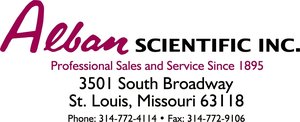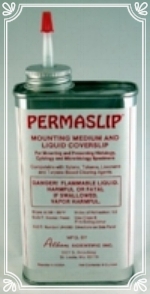Become a distributor - Call 314-772-4114
Mounting Medium & Liquid Coverslip. Fast drying, clear acrylic medium. Unique spout on 8 oz cans controls drop by drop application. Manufactured by Alban Scientific, Inc.
Part No.: 030A325A
Size: 8 Ounce Dispenser Cans
Pricing: 1 - 11 cans $26.00 ea.
12 + cans $23.00 ea.
TO ORDER CALL: 314-772-4114 OR
EMAIL: SALES@ALBANSCIENTIFIC.COM
REQUEST SDS BY EMAIL OR INCLUDE REQUEST WITH YOUR ORDER.
Fax: 314-772-9106
**Note: A $30.00 HAZMAT shipping charge MAY APPLY
APPLICATION:
Alban Scientific, Inc.'s Permaslip Mounting Medium is reliable and easy-to-use with excellent results as a standard mounting medium product or as a liquid coverslip (coverglass free) mounting medium.
Permaslip Mounting Medium can also be used in tissue/cell transfer procedures to transfer tissue sections or cell preparations from a prepared microscopic slide when specimen availability is limited and additional diagnostic workup is necessary. Examples when tissue/cell transfer with Permaslip is applicable include:
Paraffin sections of small biopsies/minimal tissue
Biopsies with a small foci of neoplasm
Paraffin block is unavailable
Cytology preparations, fine needle aspirates (FNA)
Transfer of tissue from an uncharged slide to charged slide(s)
Preparing multiple slides from a single slide preparation
Salvaging/restoring broken slides back to a whole mount
The tissue/cell transfer procedure will take time to accomplish steps properly and obtain a well prepared end product. Reduced timings or short cuts should not be taken. Practicing the technique prior to performing on specimens with limited availability is highly suggested. Cellular and staining quality of tissues/smears will not be affected and histochemical, immunohistochemistry and cytochemical procedures can be performed on transferred samples with reliable results.
METHOD:
Technique:
Coverslipping: Paraffin or frozen sections tissue/cell transfer: Stained and unstained paraffin sections, cytology preparations and smears.
COVERSLIPPING PROCEDURE:
Complete staining procedure; dehydrate, clear with xylene and blot excess xylene from slide edges.
Apply sufficient amount of Permaslip Mounting Medium to flow over and fully cover the tissue section(s).
Standard coverglass application; install coverglass, one edge first, allowing air bubbles to escape as opposite edge is lowered on to the slide.
Liquid coverglass (coverglass free) application; allow to dry for 15-20 minutes in a flat horizontal position before handling and viewing microscopically.
Dry slides a minimum of 24-48 hours before filing.
TISSUE/CELL TRANSFER PROCEDURE:
Mark the designated tissue area(s) to be the focus of the tissue/cell transfer on the underside of original slide with a HistoTec™ Pen.
For previously stained sections:
Soak original slide in xylene until coverslip is easily removed without damage to tissue section.
Run slide through several changes of xylene to ensure removal of residual mounting medium.
Do not proceed through alcohol steps.
See Procedure Note #1.
For unstained paraffin sections or smears:
Soak slides in several changes of xylene, a minimum of 10 minutes. Do not proceed through alcohol steps.
Spread Permaslip Mounting Medium on xylene-coated slides with an applicator stick or pipette tip. Use sufficient Permaslip to form a meniscus over the entire tissue section or cell preparation.
Slide must be xylene coated and not allowed to dry out.
See Procedure Note #2.
Place slide in a flat horizontal position in a 60°C oven for 90 minutes to 2 hours or in a 37°C oven overnight until meniscus hardens.
See Procedure Note #3.
Mark the surface of the hardened mounting medium meniscus to corresponding areas marked on the underside of the slide (Step #1) with HistoTec™ Pen to maintain tissue orientation in the transfer process.
Immerse slide in a Coplin jar of water warmed in a 45°C-60°C water bath; soak for 90 minutes to 3 hours.
Slowly pry meniscus off at the edges with a scalpel blade. If the mounting medium does not peel off easily, return to warm Coplin jar and continue soaking.
See Procedure Note #4.
Moisten the charged/adhesive slide(s) that will receive the transferred segment(s) with water.
Divide transferred segment into multiple sections: once meniscus is removed from the original slide, cut with a water moistened scalpel blade or surgical scissors into desired segments as marked/scored on mounting medium surface.
Place each cut segment, meniscus/curved side up, onto a moistened charged/adhesive slide in sequential order as oriented on the original slide.
To transfer one intact segment of tissue; place on the moistened charged/adhesive slide, meniscus/curved side up.
Soak a piece of gauze in warm water; place gauze over the tissue section. Using thumb, press gauze flat transferring water to the section, flattening edges and sealing transferred section to slide.
If a transferred section is inadvertently placed upside down, the specimen will not adhere to the slide and will be lost in further procedure steps.
Place slide(s) in a 37°C-60°C oven in a flat horizontal position for 1 hour or longer to securely adhere transferred section to slide.
Soak slide(s) in four changes of xylene for 10 minutes each or longer until all the Permaslip compound is completely dissolved.
See Procedure Note #5.
Re-hydrate through two changes each of 100% and 95% ethyl alcohols, 10 dips each. Wash well with distilled water.
See Procedure Note #6.
The specimen is ready for histochemical, immunohistochemical or cytochemical staining.
RESULTS:
References indicate that the staining quality of tissues/smears and antigenicity of cells after the application of this technique remain unaltered.
PROCEDURE NOTES:
If any residual mounting medium remains on the slide, tissue transfer and subsequent staining may be compromised.
Use Permaslip Mounting Medium in well ventilated areas or under a fume hood.
The meniscus of Permaslip Mounting Medium must be thoroughly hardened on the slide before proceeding. It is critical that the meniscus hardens but still remains pliable. To avoid brittleness do not exceed temperatures above 60°C during the hardening process.
If a hotplate was used in place of an oven to dry slides and/or melt paraffin after the original sectioning, it will be difficult to remove an entire intact section from the slide. Extended soaking of mounting media and tissue section does not improve results.
If Permaslip is not completely dissolved from the tissue section(s), subsequent staining may be compromised.
If necessary, decolorize previously stained transferred sections prior to performing additional diagnostic workup. Rehydration through alcohols will remove most counterstains; 1-2 minutes in Acid Alcohol 1% (Part 10011) will remove hematoxylin.
The use of xylene substitutes has not been tested with this product or technique.
REFERENCES:
Gill, Gary. Cytopreparation: Principles & Practice, Essentials in Cytopathology. New York: Springer Science and Business Media, 2013. 393-395.
Kubier, Patty and Rodney Miller. “Tissue Protection Immunohistochemistry.” American Journal of Clinical Pathology 117 (2002): 194-198.
Luna, Lee G. Manual of Histologic Staining Methods of the Armed Forces Institute of Pathology. 3rd ed. New York: Blakiston Division, McGraw-Hill, 1968. 67-69.
Miller, Rodney and Patty Kubier. "Immunohistochemistry on Cytologic Specimens and Previously Stained Slides (When No Paraffin Block is Available)." The Journal of Histotechnology 25.4 (2002): 251-257.
Weibel, E. "The Preparation of Serial Microscopic Sections in Form of Plastic Films." Lecture, Annual meeting of the International Academy of Pathology, Boston, April 1959.
Modifications developed by Newcomer Supply Laboratory.
Purchase Permaslip in the Laboratory section of our store.
Like us on Facebook!


